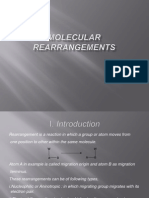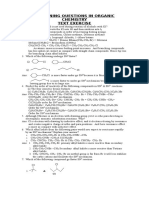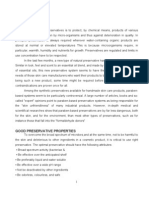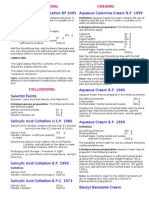Chemical Properties of Ethanol
Chemical Properties of Ethanol
Uploaded by
Kinkwan KingCopyright:
Available Formats
Chemical Properties of Ethanol
Chemical Properties of Ethanol
Uploaded by
Kinkwan KingCopyright
Available Formats
Share this document
Did you find this document useful?
Is this content inappropriate?
Copyright:
Available Formats
Chemical Properties of Ethanol
Chemical Properties of Ethanol
Uploaded by
Kinkwan KingCopyright:
Available Formats
Chemical properties of Ethanol & Phenol
KCl http://hk.geocities.com/fatherofchemistry
Objective To find out the chemical properties and pH of ethanol and phenol, and compare their differences between ethanol and phenol. Results Reaction of ethanol: Properties Observation Corresponding equations (if any) / s / Smell Reactions pH of universal / solution indicator remains green, pH=7 Triiodometh yellow C2H5OH + 4I2 + 6NaOH CHI3(s) + HCOO-Na+ ane precipitate + 5NaI + 5H2O reaction found at bottom of test-tube, with odour smell Reaction Na sinks to 2C2H5OH + 2Na 2C2H5O-Na+ + H2(g) with Na bottom, colourless gas, which gives a 'pop' sound to burning splint, evolves slowly and moderately. When ethanolethoxide mixture in test-tube is poured onto a petri-dish, small, colourless
rectangularshaped crystals are formed in a few minutes. Esterificatio When the n mixture of ethanol, ethanoic acid & conc.H2SO4 in test-tube is poured into Na2CO3 solution, a smell like allpurpose adhesive is noticeable.
Reaction of phenol: Proper Observa ties / tions / Reacti Smell ons Solubili phenol ty in dissolves water: gradually (a) a on little shaking phenol insoluble, (b) a phenol lot of forms oilphenol like droplets on shaking (soluble when heated) pH of universal solutio indicator n changes from green to orange, Corresponding equations (if any)
i.e. acidic Reactio phenol n with becomes NaHCO insoluble after 3 adding NaHCO3 and forms a emulsion on shaking Reactio Solubility n with of phenol NaOH in NaOH is much higher than in water. After adding conc. HCl, phenol becomes insoluble (appear as droplets) again. Reactio Na floats n with and Na evolves a colourless gas, which has a 'pop' sound on burning splint test, gradually (but faster than in ethanol)
Reactio Br2 n with decolouri bromin zed e water readily in presence or absence of light, which indicates that this is not a free radical substituti on reaction. A white precipitat e is formed. Reactio The n with colour of 'neutral FeCl3 ' FeCl3 changes from yellow to violet. The same colour change is not take place in ethanol.
*The violet complex formed between phenol and Fe3+ is still not well-known
KCl
http://hk.geocities.com/fatherofchemistry
Precaution 1.> The filter paper, which have been soaked with paraffin oil on sodium metal, should be thrown properly since the unreacted sodium remains on the paper may cause a fire. 2.> Ensure that all sodium is reacted in test-tube before disposing the liquid. 3.> Avoid adding too large sodium to ethanol or phenol since
the reaction may be to vigorous. 4.> Avoid contact with the crystal of phenol. If you contact with it accidentally, wash your hands with glycerol or plenty of water, or your hands may have white strain due to phenol's corrosive property. Discussion 1.> The smell of phenol is close to that in hospital. 2.> Both pH test (acidic in phenol, neutral in ethanol), iodoform test (+ve in ethanol), solubility test (miscible between ethanol & water), reaction with NaHCO3 (phenol is insoluble), reaction with Br2 water (phenol decolourize Br2) and reaction with neutral FeCl3 (Fe3+ and phenol forms a violet complex) can distinguish between ethanol & phenol. 3.> Phenol is much more soluble in NaOH than in water because the reaction between phenol and water to form H3O+ & phenoxide is reversible (since phenol is a weak acid, most H+ formed will combine with phenoxide to form phenol again) whereas that between phenol and NaOH is not and the formation of phenoxide ion is promoted:
Na+ & phenoxide ions are then dispersed by water molecules, thus phenol is highly soluble in NaOH. 4.> Compare their reactions with Na, H2 evolves faster in phenol than in ethanol due to the acidic nature of phenol. The acidity of an acid is depends on the relative stabilities of the acid (HA) & its conjugate base (A ). The more stable the conjugate base A-, the stronger is the acid. In case of phenol, the phenoxide ion is stabilized by delocalization
of p-electrons (the charge on O is more disperse & lower its charge density):
The equilibrium of shifts to right and thus phenol is acidic. However, in case of ethanol, alkyl group is electrondonating group, which makes ethoxide ion unstable (C2H5O-), thus it's neutral. 5.> In the reaction with NaOH, the further addition of conc. HCl makes phenol becomes insoluble again which shows that phenol is a weaker acid than mineral acids. 6.> Phenol has an electron-rich centre (benzene ring) to attract electrophiles to attack and electron-donating hydroxyl group further increase its nucleopilicity. This makes phenol has a much higher reactivity than benzene and react with Br2 readily even in the absence of catalyst & light. On the other hand, ethanol is saturated and has no electron-rich centre, thus no reaction between ethanol and Br2. 7.> Some of the reactions in this experiment is useful and is usually used for daily life. For example, (a) Iodoform reaction is used to prepare a compound that is one carbon less than previous one and iodoform itself can be used as pesticide. (b) Phenol and it's derivatives can be used as antiseptics so it's quite common to smell their smell in hospital. (c) Esterification can be used to synthesize esters in perfumes. (d) Phenol can be purified by adding NaOH to phenol and organic compound mixtures, sodium phenoxide can then be crystallized and separated, phenol is regenerated by adding H+.
(e) FeCl3, Br2 and NaOH are used to test the presence of phenol if all these three tests show positive result. Conclusion Both ethanol and phenol are widely used compounds, especially in disinfectant. To distinguish them, several tests are needed, since other compounds may also be positive on these tests. If all of these test shows positive result, then the uncertain organic compound may be either one of them.
You might also like
- Aldol Condensation LabDocument6 pagesAldol Condensation LabChristian AmpeNo ratings yet
- Alcohol Phenol and EthersDocument25 pagesAlcohol Phenol and EthersAyaz100% (2)
- EXP4 The Diels Alder ReactionsDocument3 pagesEXP4 The Diels Alder ReactionsLaura GuidoNo ratings yet
- Isolation of Acetylsalicylic AcidDocument4 pagesIsolation of Acetylsalicylic AcidPrince Pulvera100% (1)
- Aliphatic Hydrocarbons: LAB #1 Reactions of HydrocarbonsDocument7 pagesAliphatic Hydrocarbons: LAB #1 Reactions of HydrocarbonsJoshuaArryNo ratings yet
- Qualitative Organic Analysis - Sem 3Document37 pagesQualitative Organic Analysis - Sem 3Reshma SomanNo ratings yet
- Organic Chemistry ReactionsDocument9 pagesOrganic Chemistry ReactionsofferwindumaliyamogamNo ratings yet
- Experiment 2 Alcohols and PhenolsDocument3 pagesExperiment 2 Alcohols and PhenolsJustine MarieNo ratings yet
- Expt6 Synthesis of An Alkyl Halide DraftDocument6 pagesExpt6 Synthesis of An Alkyl Halide DraftAnna Sophia EbuenNo ratings yet
- Chapter 18 - Carbonyl CompoundsDocument9 pagesChapter 18 - Carbonyl CompoundsNabindra RuwaliNo ratings yet
- Alcohols and Phenols (4 Files Merged)Document101 pagesAlcohols and Phenols (4 Files Merged)umarNo ratings yet
- Alkanes & Alkenes: Combustion and Action of Sulphuric AcidDocument7 pagesAlkanes & Alkenes: Combustion and Action of Sulphuric AcidNg Sin HuiNo ratings yet
- Functional Group Analysis 1Document17 pagesFunctional Group Analysis 1حسين أحمد حسينNo ratings yet
- Green Chemistry ExperimentDocument3 pagesGreen Chemistry ExperimentAnnalisa GiammòNo ratings yet
- Aldol CondensationDocument10 pagesAldol CondensationVanessa Nguyen0% (1)
- FHSC1124 Tutorial Ebook QDocument72 pagesFHSC1124 Tutorial Ebook QTeo CinnyNo ratings yet
- Organic Chemistry ReactionsDocument21 pagesOrganic Chemistry ReactionsAbid KhanNo ratings yet
- Carboxylic Acid Lab ReportDocument7 pagesCarboxylic Acid Lab Reportretsen30002No ratings yet
- Synthesis of An Alkyl HalideDocument4 pagesSynthesis of An Alkyl HalideJoseph CatiisNo ratings yet
- Department of Chemical Engineering, University of The Philippines, Diliman, Quezon CityDocument2 pagesDepartment of Chemical Engineering, University of The Philippines, Diliman, Quezon CityElaine Nicole CanebaNo ratings yet
- Conjugated Compounds and Ultraviolet SpectrosDocument26 pagesConjugated Compounds and Ultraviolet SpectrosElla MihNo ratings yet
- Organic Chemistry Experiment 8Document3 pagesOrganic Chemistry Experiment 8Rogeni Misaelle PetinglayNo ratings yet
- SCH 206 Week 1 Lecture NotesDocument52 pagesSCH 206 Week 1 Lecture NotesDemis ZelelewNo ratings yet
- Carbonyl Compounds Aldehydes KetonesDocument58 pagesCarbonyl Compounds Aldehydes KetonesNur Aliyah Abdul RazakNo ratings yet
- Practical Guide EdexcelDocument43 pagesPractical Guide EdexcelUsman BokhariNo ratings yet
- Sample Lab Report BenzophenoneDocument6 pagesSample Lab Report BenzophenoneFernandaNo ratings yet
- Organic Review Worksheet and Problem SetDocument20 pagesOrganic Review Worksheet and Problem SetNelNo ratings yet
- Medina CollegeDocument20 pagesMedina CollegeOtencianoNo ratings yet
- Lab Report Organic ChemistryDocument6 pagesLab Report Organic Chemistryszairah jumalonNo ratings yet
- Lab Manual FGS0074Document8 pagesLab Manual FGS0074hash117No ratings yet
- Aldehydes Ketones HaccDocument66 pagesAldehydes Ketones HaccRammohan VaidyanathanNo ratings yet
- Sn1 and Sn2 Reactions Write UpDocument6 pagesSn1 and Sn2 Reactions Write UpLevy Medina TrayaNo ratings yet
- Aldehydes and Ketones: Answers To QuestionsDocument3 pagesAldehydes and Ketones: Answers To Questionsmark pascuaNo ratings yet
- Lab Experiment 21 Report: Organic Chemistry Lab Tuesdays at 1:30Document4 pagesLab Experiment 21 Report: Organic Chemistry Lab Tuesdays at 1:30Johnathan DoeNo ratings yet
- PYRROLESDocument13 pagesPYRROLESRaj BrothersNo ratings yet
- Corrected Fundamentals of Organic ChemistryDocument71 pagesCorrected Fundamentals of Organic ChemistryDAM2120No ratings yet
- Insrumental Analysis ManualDocument62 pagesInsrumental Analysis ManualFemola97No ratings yet
- Organic ChemistryDocument8 pagesOrganic ChemistryAndré Brincat100% (1)
- Determination of Boiling Point of Organic CompoundsDocument28 pagesDetermination of Boiling Point of Organic CompoundsDotsha Raheem83% (6)
- Acyl Chloride PresentationDocument20 pagesAcyl Chloride PresentationGanga Jones Manodon Ducyogen100% (1)
- Cannizarorxn 120207190937 Phpapp01Document71 pagesCannizarorxn 120207190937 Phpapp01Adrian PINo ratings yet
- Experiment 32Document14 pagesExperiment 32Morgan Elizabeth Lepley100% (6)
- Preparation of Alkyl Halides by Nucleophilic Aliphatic Substitution NewDocument9 pagesPreparation of Alkyl Halides by Nucleophilic Aliphatic Substitution NewMunna Patel0% (1)
- Alpha Carbon Chemistry - Enols and EnolatesDocument49 pagesAlpha Carbon Chemistry - Enols and EnolatesKuku MandavaNo ratings yet
- Chem 5-1st Post Lab DiscussionDocument41 pagesChem 5-1st Post Lab DiscussionJesselie SalayaNo ratings yet
- Experiment 1 - ATQDocument2 pagesExperiment 1 - ATQAndrea Nicole RocafortNo ratings yet
- Class XII: Chemistry Chapter 11: Alcohols, Phenols and Ethers Top Concepts 1. Structure of Alcohols, Phenols and EthersDocument10 pagesClass XII: Chemistry Chapter 11: Alcohols, Phenols and Ethers Top Concepts 1. Structure of Alcohols, Phenols and EthersAshaNo ratings yet
- Aldol Reaction - Addition - Condensation - Mechanism - AdichemistryDocument7 pagesAldol Reaction - Addition - Condensation - Mechanism - AdichemistryBiswa Bhusan NayakNo ratings yet
- Fundamental Organic Chemistry (I) : 231 (Lab Manual)Document57 pagesFundamental Organic Chemistry (I) : 231 (Lab Manual)Trıstan OdsinadaNo ratings yet
- Ketones and AldehydesDocument10 pagesKetones and AldehydesManjeeta Mandlik0% (1)
- Molecular RearrangementsDocument158 pagesMolecular RearrangementsRamesh Katkam75% (4)
- Reactions of Alcohols, Phenols, Aldehydes and KetonesDocument44 pagesReactions of Alcohols, Phenols, Aldehydes and KetonesGlen Mangali100% (4)
- Synthesis and Characterization of TrisDocument1 pageSynthesis and Characterization of TrisforfunNo ratings yet
- Lab+Manual+2014 Cbe 2207Document63 pagesLab+Manual+2014 Cbe 2207Krishnan Mohan100% (1)
- 2 BenzophenoneDocument3 pages2 BenzophenoneElizabeth LawsonNo ratings yet
- 06 Chapter 1Document63 pages06 Chapter 1Dintakurthi PrasanthNo ratings yet
- Suzuki Reaction Organic ChemistryDocument7 pagesSuzuki Reaction Organic ChemistryjaudrenNo ratings yet
- Experiment 8 The Preparation of AcetanlideDocument12 pagesExperiment 8 The Preparation of AcetanlideRadhwanNo ratings yet
- Organic - Lab 8 - ReductionDocument6 pagesOrganic - Lab 8 - ReductionQuynhTrang DaoNo ratings yet
- Benzoin Exp7Document4 pagesBenzoin Exp7Liz Hackett0% (1)
- Exp 3 Grignard Report UpDocument5 pagesExp 3 Grignard Report UpUyen V. NguyenNo ratings yet
- PhenolDocument3 pagesPhenolShi Han75% (4)
- Adhesives For WoodDocument500 pagesAdhesives For WoodJoão Victor WorkNo ratings yet
- Reasoning Ques in Organic ChemistryDocument14 pagesReasoning Ques in Organic ChemistryRIHINBHATNAGAR50% (2)
- Chemical Weekly Dec15Document196 pagesChemical Weekly Dec15hello8434No ratings yet
- 10 Haloalkanes and Haloarenes 1 MK QuestionsDocument42 pages10 Haloalkanes and Haloarenes 1 MK QuestionsPriyanks RoutNo ratings yet
- PhenolsDocument34 pagesPhenolsLoran Prelya TengayNo ratings yet
- Disinfection For PH 2Document73 pagesDisinfection For PH 2Boas WayneNo ratings yet
- 1 s2.0 S1383586618337912 MainDocument22 pages1 s2.0 S1383586618337912 MainPau LunaNo ratings yet
- A Survey Report On PreservativesDocument46 pagesA Survey Report On Preservatives0921pyNo ratings yet
- Sterilization in OrthodonticsDocument121 pagesSterilization in OrthodonticsSwati PawarNo ratings yet
- Alcohol Jeemain - GuruDocument36 pagesAlcohol Jeemain - GuruSailost Jr.No ratings yet
- Chemical Weekly Sep08Document202 pagesChemical Weekly Sep08Anand KNo ratings yet
- Daftar Bahan Berbahaya Dan Beracun (B3) Rumah Sakit Eka Di BSDDocument78 pagesDaftar Bahan Berbahaya Dan Beracun (B3) Rumah Sakit Eka Di BSDReniNo ratings yet
- Expt 8ADocument74 pagesExpt 8APearl Azucena100% (3)
- Hydroxy CompoundsDocument9 pagesHydroxy Compoundschong56No ratings yet
- Chapter 11 - Alcohols, Phenols and EthersDocument20 pagesChapter 11 - Alcohols, Phenols and EthersMr HackerNo ratings yet
- Synthesis of Schiff Base Ligand Using 2 - 1Document6 pagesSynthesis of Schiff Base Ligand Using 2 - 1AHLBAIT TVNo ratings yet
- Proceeding Bromometric Phenol Assay Without Starch IndicatorDocument6 pagesProceeding Bromometric Phenol Assay Without Starch IndicatorAsiyahNo ratings yet
- Phenbol ReactionDocument3 pagesPhenbol Reactionilias1973No ratings yet
- Exercise-01 Check Your Grasp: CH CL (A) CH CL (B) CHDocument29 pagesExercise-01 Check Your Grasp: CH CL (A) CH CL (B) CHRajiv KabadNo ratings yet
- Chemistry STPM Sem 3 MSAB Pre Trial Answer PDFDocument2 pagesChemistry STPM Sem 3 MSAB Pre Trial Answer PDFajakazNo ratings yet
- Alcohols Phenols and EthersDocument10 pagesAlcohols Phenols and EthersManan SethiNo ratings yet
- Solubility of Organic CompoundsDocument3 pagesSolubility of Organic CompoundsJmNo ratings yet
- Free Sample Authentic Shortcuts Tips Tricks in Chemistry For Jee Main Advanced KvpyDocument40 pagesFree Sample Authentic Shortcuts Tips Tricks in Chemistry For Jee Main Advanced KvpylivesanyamNo ratings yet
- Amro DamanhouryDocument22 pagesAmro DamanhourySujith Thomas0% (2)
- F324 All QuestionsDocument95 pagesF324 All QuestionsIntesar NurNo ratings yet
- Alcohols Phenols and Ethers - MTG.Self-Assessment - QnsDocument3 pagesAlcohols Phenols and Ethers - MTG.Self-Assessment - QnsVeankatapathy 613 Xl group BNo ratings yet
- Chapter No. 18 Alcohols Phenols & Ethers McqsDocument2 pagesChapter No. 18 Alcohols Phenols & Ethers McqsAbdul Qayyum100% (1)
- Chem 120.1 Laboratory Report No. 7Document4 pagesChem 120.1 Laboratory Report No. 7JM BoylesNo ratings yet

























































































